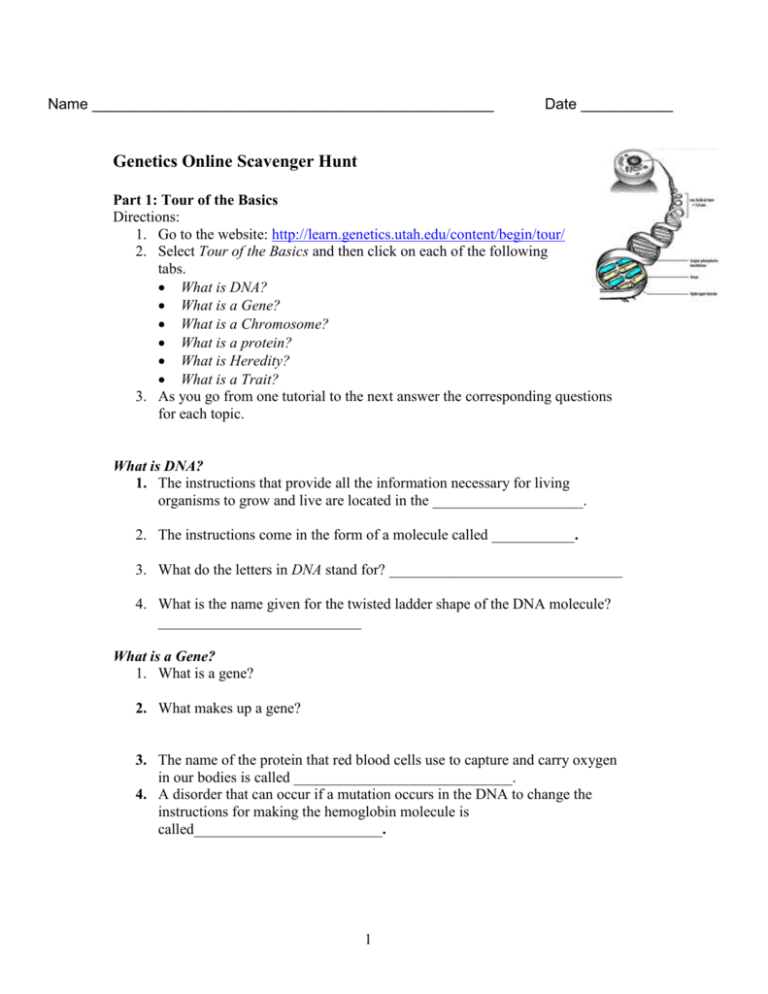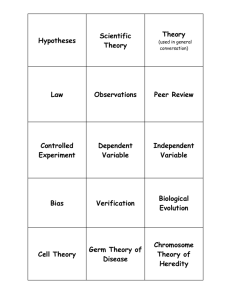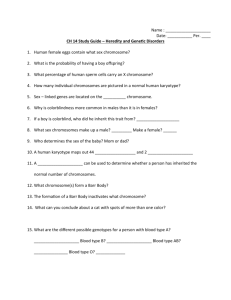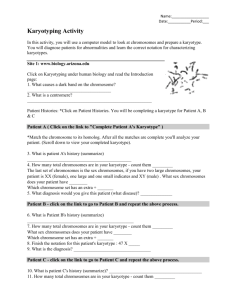Genetics Scavenger Hunt: DNA, Genes, and Heredity
advertisement

Name ________________________________________________ Date ___________ Genetics Online Scavenger Hunt Part 1: Tour of the Basics Directions: 1. Go to the website: http://learn.genetics.utah.edu/content/begin/tour/ 2. Select Tour of the Basics and then click on each of the following tabs. What is DNA? What is a Gene? What is a Chromosome? What is a protein? What is Heredity? What is a Trait? 3. As you go from one tutorial to the next answer the corresponding questions for each topic. What is DNA? 1. The instructions that provide all the information necessary for living organisms to grow and live are located in the ____________________. 2. The instructions come in the form of a molecule called ___________. 3. What do the letters in DNA stand for? _______________________________ 4. What is the name given for the twisted ladder shape of the DNA molecule? ___________________________ What is a Gene? 1. What is a gene? 2. What makes up a gene? 3. The name of the protein that red blood cells use to capture and carry oxygen in our bodies is called _____________________________. 4. A disorder that can occur if a mutation occurs in the DNA to change the instructions for making the hemoglobin molecule is called_________________________. 1 What is a Chromosome? 1. How long would your DNA be if it were stretched out? ____________________ 2. DNA is packaged in units called____________________________. 3. How many chromosomes do humans have?___________ 4. How many pairs of chromosomes do humans have?______ 5. Which chromosomes determine whether you are male or female? _______________________________________________________ What is a Protein? 1. Each gene in the DNA molecule encodes information about how to make individual ____________________________. 2. The protein-making machinery, the _____________________ produce a _________________________ based on the DNA instructions. What is Heredity? 1. Our ______________ encode the instructions that define our traits. 2. How do we get traits from our parents? What are Traits? 1. What is a trait? 2. What are physical traits? 3. What are behavioral traits? 2 Part 2: Heredity and Traits? Directions: 1. Go back to the homepage, http://learn.genetics.utah.edu/index.html 2. Click on Heredity and Traits. 3. Scroll down the next page and find the following topics: a. How Do Scientists Read Chromosomes? b. Making a Karyotype c. Using Karyotypes to Predict Genetic Disorders 4. As you go from one tutorial to the next answer the corresponding questions for each topic. How Do Scientists Read Chromosomes? 1. What are the three key features that scientists use to identify similarities and differences on chromosomes? a. b. c. 2. For what process are centromeres required? 3. Centromeres are attached to microtubules (spindle fibers), which are proteins that can pull chromosomes toward ___________________ ends of each cell before the cell divides. 4. This ensures that each daughter cell will have a full set of _________________________. Making a Karyotype 1. What is a karyotype? 2. How are chromosomes arranged and numbered in a karyotype? by __________________, from __________________ to____________________. 3. This arrangement helps scientists quickly identify chromosomal alterations that may result in a _______________________________. 4. List the three steps scientists use to make a karyotype. a. b. c. 3 Using Karyotypes to Predict Genetic Disorders 1. List the three typical differences found in karyotypes. a. b. c. 2. Circle either yes or no for the next three items. Can scientists see the following in a karyotype? a. Individual DNA strands or genes? YES NO b. The number of genes in any given area of a chromosome? YES NO c. The presence or location of small mutations? YES NO Part 3: Genetic Disorder Library Directions: 1, Go back to the home page: http://learn.genetics.utah.edu/index.html 2. Click on Genetic Disorder Library. 3. Click on a disorder from the following table and include information about the causes and characteristics of the disorders... Genetic Disorder 1. Down Syndrome Cause 2. Turner Syndrome Girls have only one x chromosome 3. Klinefelter Syndrome 4. Cri du Chat Syndrome 5. Williams Syndrome 4 Characteristics of Disorder Mental retardation Eyes slant upward Heart defects 5











